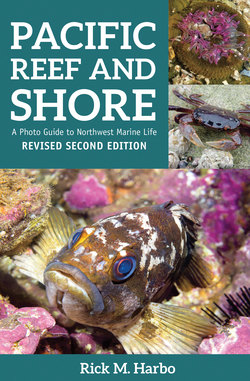Читать книгу Pacific Reef and Shore - Rick M. Harbo - Страница 6
На сайте Литреса книга снята с продажи.
ОглавлениеIntroduction
Thousands of fascinating creatures inhabit the beaches, tidepools and waves of the Pacific Northwest, and more than 300 species of marine animals and plants listed in this field guide are just those most commonly seen along the coast of Alaska, British Columbia, Washington, Oregon and northern California. Wonderful surprises await anyone—from the first-time beachcomber to the seasoned scuba diver—who spends an afternoon looking closely at the wildlife of our marine shores and waters.
Tides and Currents
Whether you are boating, diving or just walking along the seashore, you must be aware of the tides and currents in the area you are exploring. The earth’s waters rise and recede, drawn by the gravitational pull of the moon, and to a lesser extent the sun. Tidal changes can be extreme, with a daily range in water height or depth of as much as 20’ (6 m) in some locations. Tidal changes also cause swift currents at narrows where water flow is constricted. Tide and current tables, published by government agencies, are available online, at marinas, and sporting goods stores.
The best time to view marine life is during the two hours before and after the lowest tide, generally less than 2’ (60 cm) in the USA and less than 3’ (1 m) in Canada. If you are an experienced diver and you plan to visit current-swept areas for the rich marine life, plan your dives for slack times, as the tides change direction.
The intertidal area of the beach is the part that is submerged at high tide and exposed at low tide, a habitat where many animals and plants are covered and uncovered by water twice a day. Creatures that live here are adapted to the high, mid- and/or low intertidal zones. The subtidal area is the shallow water, that part of the salt water that is within diving range (less than 100’/30 m deep). Species here are always submerged, and they live in conditions of much less rugged surf and exposure to weather than intertidal dwellers.
Names of Species
Almost every plant and animal has a common name, usually local and often colourful, such as the northwest ugly clam. The scientific name (Entodesma navicula for the northwest ugly clam), is a unique name composed of two words and registered with an international organization, gives scientists a standard, precise way of communicating information about a particular organism.
Scientific classifications and names are constantly under review as more is learned about wildlife, and species names change frequently, so there are often many synonyms for a given plant or animal. Many names have been updated in this second edition. Search the World Registry of Marine Species (WoRMS) for current accepted names and synonyms, http://www.marinespecies.org.
Marine Conservation
This guidebook is intended to help you identify animals and plants in their habitat without having to collect or otherwise disturb them. That is the best way to understand the relationships between organisms and their environment, and to protect them for future generations to observe and enjoy.
If you must take specimens, be aware of local Fisheries regulations and licensing requirements. Wherever possible, collect organisms from man-made structures such as docks and pilings. Take as few specimens as possible and avoid individuals that are laying or guarding eggs, or engaged in reproductive behaviours. If you dig into sand or mud, or turn over rocks, replace the disturbed material carefully and immediately. Avoid stepping on plants and animals.
There are many threats to the marine environment, including overfishing, pollution and habitat destruction. Many local or international marine conservation groups are active, and they will be glad to provide you with more information on enjoying and caring for the natural wonders of the coastline.
